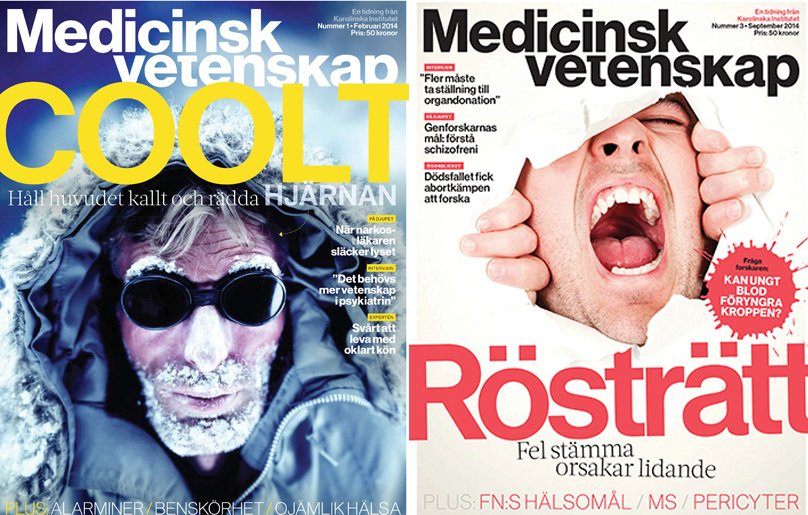The use of new nicotine products such as white snus and e-cigarettes has increased significantly among young people in Sweden. Marketed as tobacco-free, these products often contain high levels of nicotine and are flavoured in ways that attracts new target groups. But what do we really know about the risks?
Text: Annika Lund, first published in Medical Science No. 2 2024 / Spotlight in new nicotine products
For many years, smoking rates have been declining in Sweden. In 2022, a total of six percent of Swedes reported smoking daily. Approximately the same number smoke occasionally.
In the younger age groups, daily smokers are even fewer, with only 4 percent of 16- to 29-year-olds smoking every day. However, 8 percent of them smoke occasionally, “social smoking”, which is more than in the higher age groups. The highest proportion of daily smokers is found in the oldest age group, 65 to 84 years. All figures are sourced from the Public Health Agency of Sweden’s national survey, Health on Equal Terms.
But the scene has changed. A beleaguered tobacco industry has launched new products and is now recruiting new, young customers. It is primarily the white, candy-flavoured snus introduced in Sweden in 2016, that is spreading in schools. E-cigarettes, or vaping, which also reached the Swedish market in the 2010s, have taken hold, particularly among young people.
Facts: New nicotine products
E-cigarettes or vaping: E-juice, also known as e-liquid, is heated using a battery, and the vapor is inhaled. E-juice comes in various flavours and can contain nicotine or can be nicotine-free. Different e-cigarettes models exist, some with rechargeable batteries and adjustable features like wattage. There are also disposable e-cigarettes that are discharged (with battery) after use.
White snus, nicotine pouches or nicotine snus: Nicotine levels vary and can be much higher than in brown snus.
Heat-not-burn or heated tobacco products (HTP): These products heat tobacco to produce inhalable vapor.
Source: Tobaksfakta.se and others.
In June 2023, the Public Health Agency of Sweden submitted a report to the government, “Knowledge about the Health Effects of Tobacco and Nicotine Products”. It states that knowledge about new products, such as e-cigarettes and white snus, is limited. However, the Public Health Agency of Sweden writes, while knowledge is being built up, that one must start from what is already known about the harmful substances they contain, primarily nicotine.
Nicotine is a toxic and highly addictive substance. In new tobacco products, such as white snus and e-cigarettes, nicotine is extracted from the tobacco plant. One of the inventors of white snus, Swedish pharmacist Thomas Ericsson, has said in interviews that it is “completely wrong” and “misleading” to call nicotine pouches tobacco-free.
Yet, the term ‘tobacco-free snus’ is so established that it has escaped legislation for tobacco products – when the actual tobacco leaves are not included, the Tobacco Act is not deemed to apply. Therefore, until 2022, white snus could be legally sold to individuals under 18 years of age and marketed despite the advertising bans in the Tobacco Act.

Vascular stiffness after vaping
One who early investigated the health effects of the new tobacco products is , associate professor of cardiology at the Department of Clinical Sciences, Danderyd Hospital. His research career began with studies on how blood vessels are affected by diesel exhaust. With the same methods, he has studied cigarettes, both conventional and vaping.
His first study on e-cigarettes, published in 2016, included 16 infrequent vapers who were asked to puff ten times on an e-cigarette over the course of ten minutes. Various controls were conducted over a 24-hour period. All values were compared with the study participants’ own over a 24-hour period when they had not vaped.
One hour after vaping, biomarkers in the blood indicative of vascular damage were found. After 24 hours, however, the levels had returned to normal.
In recent studies, his research team have been able to show more acute effects from e-cigarettes. Shortly after vaping, airways are narrower, blood vessels are stiffer and blood-clotting properties increase.
Research on conventional cigarettes reveals a similar pattern: occasional use causes acute harm that eventually subsides. However, smoking conventional cigarettes over many years leads to chronic issues, including vascular stiffness, increasing the risk of heart attacks and strokes. The long-term effects of vaping remain unexplored, according to Magnus Lundbäck.
Interestingly, nicotine-free e-cigarettes do not produce the same vascular effects.
“The conclusion is that it is the nicotine itself that causes the damage,” says Magnus Lundbäck.
Conventional cigarette smoke contains thousands of substances, such as tar, arsenic and hydrogen cyanide. Separating nicotine’s specific effects from this toxic mix has been challenging. Despite knowing for decades that conventional cigarettes harm vascular health, distinguishing between smoke and nicotine’s impact has proven difficult. Tobacco companies have positioned smoke-free cigarettes, i.e. e-cigarettes, as less harmful, suggesting they are a viable alternative for those who want to quit conventional cigarettes.
Helpful aid or gateway to addiction
This question is central to the discussions about new tobacco products. Is vaping a helpful aid for quitting smoking conventional cigarettes, or does it serve as a gateway for young people who have not previously used tobacco products? Or perhaps is it both? If so, how should the benefits balance against risks?
The New England Journal of Medicine recently published a study involving nearly 1 250 smokers who wanted to quit. Participants were randomly assigned to two groups: one group received standard smoking cessation treatment plus free, optional nicotine replacement therapy, while the other received standard smoking cessation treatment plus free e-cigarettes.
All participants set a quit date. After six months, 29 percent of the vapers had successfully quit and remained smoke-free, confirmed by urine tests. In the control group, progress was slower. Only 16 percent quitting on their planned quit date.
Interestingly, vapers clung more tightly to their nicotine habit. At the same six-month follow-up, 20 percent of those who vaped had completely quit nicotine. In the control group, the corresponding figure was 34 percent. Additionally, vapers experienced more respiratory issues, such as coughing.
Does this mean that e-cigarettes are beneficial for quitting, or do they perpetuate nicotine dependence?
Magnus Lundbäck emphasises that the long-term effects of e-cigarette use remain unexplored.
“The industry would like nothing more than for people like me to say that e-cigarettes are less harmful than conventional cigarettes. But why compare them to something as incredibly harmful to health as cigarettes? If that were the case, we should be highlighting the fact that conventional cigarettes are less dangerous than crack, but we are not. The only reasonable thing is to compare e-cigarettes with regular clean air, to compare use with non-use,” he says.
Independent nicotine researchers face scrutiny from the tobacco industry,” says Magnus Lundbäck. Following the publication of the 2016 study, industry-sponsored researchers challenged the interpretation of e-cigarettes as harmful.
“I think that is entirely appropriate. Everyone has the right to comment on research. We addressed their objections in a response we sent to the journal. In one passage, we mentioned that our critics had conflicts of interest because they were sponsored by the e-cigarette industry,” says Magnus Lundbäck.
Shortly afterward, a subpoena arrived in the mailbox. The sender? Researchers with conflicts of interest to the industry. The journal received the same message. All this occurred during correspondence before publication. The result was that the journal backed down, and the section highlighting the conflicts of interest was removed. The rest was published.
“We have more examples of how closely we are monitored. For instance, representatives of the nicotine lobby were present and filmed an entire doctoral thesis defence a while back. Then they compiled a rather peculiar summary and published it through their own channel,” Magnus Lundbäck recalls.

, a professor at the Institute of Environmental Medicine at Karolinska Institutet, describes a tobacco industry that seeks to portray its products in a positive light.
-“They often talk about harm reduction. They want to describe e-cigarettes as products that help existing smokers quit. Some people do use them for that purpose, which is good. However, we also know that many start their nicotine use with these products, making them gateways simultaneously. Overall, e-cigarettes are detrimental to public health,” she says.
According to the Public Health Agency of Sweden’s Health on Equal Terms survey, e-cigarettes use is highest among young people aged 16 to 29.
“What I can contribute is striving to conduct high-quality studies that demonstrate how these products affect health. And then I can try to disseminate that knowledge,” says Lena Palmberg.
Effects on lungs are studied
An ongoing project in her research group focuses on how e-cigarettes impact lung health. It will culminate in a doctoral thesis expected to be completed in autumn 2024. Some of the research relies on data collected through the so-called BAMSE project. Originally centred around asthma and allergies, it has expanded over time to cover additional questions.
BAMSE includes children born between 1994 and 1996. When they were between 22 and 25 years old, they answered new questionnaires and provided fresh samples. This data collection occurred between 2016 and 2019, during a period when new nicotine products had been on the market for a shorter duration.
A total of 3 055 young people participated in the study. One-third used some form of tobacco product, either daily or occasionally. Cigarettes were most common, used by 20 percent, followed by snus, used by 15 percent. Additionally, 3.9 percent of the youth used e-cigarettes.
Combination use was prevalent. Those who used both conventional cigarettes and e-cigarettes experienced more lung issues. They were more likely to have respiratory problems or wheezing compared to those who only smoked or only vaped. The same trend applied to mucus production (a need to cough up phlegm in the mornings) and recurring cough problems.
These findings confirm other studies that suggest combination use leads to greater lung impact.
“We do not know the exact cause. However, the flavour in e-cigarettes are approved as food ingredients. What happens when they are heated to several hundred degrees and inhaled has not been studied. Clearly, the effects would differ from ingesting them,” says Lena Palmberg.
Researchers have explored the effects of e-cigarettes using two lung models made from human lung cells. One model simulates the tissue in the large airways (bronchi), while the other represents the air sacs at the end of the airway branches (alveoli).
These lung models were exposed to puffs from e-cigarettes with two variants of e-juice. One flavour contained raspberry, orange, lemon, and lime, while the other featured ripe strawberries, sweet apples, and tangy kiwi. E-juice without nicotine or with low-strength nicotine (3 mg/ml) was used.
The researchers then examined what happens at the cellular level withing these lung models. They observed a complex pattern of tissue damage and inflammatory responses. The harmful effects of e-cigarettes depend on factors such as flavouring, nicotine levels, and e-cigarette setting, in which can vary in different parts of the airways, i.e. in the bronchi or alveoli.
Understanding the health risks is challenging
A key conclusion from the study is that understanding the health risks associated with e-cigarette use is challenging. With a multitude of flavours and adjustable battery wattage (which affects e juice temperature), users’ choices play a role in how their lungs are affected.
“We know enough to be able to say that no matter how you mix or adjust it, e-cigarette use is harmful,” says Lena Palmberg.
In summary, researchers find it difficult to definitely assess the long-term dangers of e-cigarettes, but they do observe acute effects. As for white snus, the knowledge base remains scarce. It is challenging even to determine how white snus use truly looks.

, professor at the Department of Global Public Health at Karolinska Institutet, highlights several statistical sources commonly used in this context. These include the Public Health Agency of Sweden’s Health on Equal Terms, The ³Ô¹ÏÍøÕ¾ School Survey by CAN (Centralförbundet för alcohol- och narkotikaupplysning) , and the City of Stockholm’s Stockholm survey.
Snus use has increased sharply among girls
Navigating the data reveals that white snus use surged among girls when entered into the market. In the early 2010s, six percent of girls in the second year of secondary school had used snus in past 30 days. By 2023, the corresponding figure is 22 percent. For boys, the increase is also notable, though not as steep. These figures include both brown and white snus.
Recent health surveys have started specifically asking about white snus. CAN was the first to inquire about white snus in 2021. In the latest report from 2023, 22 percent of girls and 27 percent of boys in the second year of secondary school reported using white snus in the past 30 days.
Meanwhile, smoking rates have declined steadily. “In a steady downward trend, men’s smoking rates have decreased since the 1970s, and women’s since the 1990s,” says Rosaria Galanti.
“This steady decline in smoking has been going on for a long time and cannot be attributed to the big change in snus use that has occurred in recent years,” she continues.
The existing statistics do not support the claim that white snus is a product people turn to when quitting smoking. But what lies behind the graphs? How often do these young people, who have used white snus in the last 30 days actually use it? – What strengths do they choose? How much nicotine do they consume? Are they adopting other tobacco products? Rosaria Galanti hopes to explore these questions in an ongoing tracking how tobacco and nicotine use evolves over time.
She has already conducted a study involving over 3 000 eleven-year-olds, following them with annual check-ups until they reached 18 years old. However, this study was conducted before the emergence of new tobacco products. Regarding conventional cigarettes and brown snus, the average age for boys to start smoking was lower than that of girls, but girls became addicted more quickly. Many who began with cigarettes later added snus, and vice versa. The equivalent patterns for today’s youth, who are also exposed to new products, remain unknown.
“The only way to find out is to follow a group of young people over time,” says Rosaria Galanti.
Friends and price are important factors
Older knowledge highlights factors influencing smoking or snus initiation. Having parents or, especially, friends who use tobacco normalises its use. Another risk factor is mental illness.
Nicotine has a mood-regulating effect and can calm anxiety and stress. “We also observe that people with certain diagnoses, such as ADHD, use nicotine more frequently than others,” says Rosaria Galanti.
Additionally, the macrosystem, i.e. society’s policies, laws, and regulations, plays a role. The most significant deterrent to tobacco use is high prices.
“There is strong scientific evidence supporting this. Higher prices prevent smoking in all groups, especially among young people,” says Rosaria Galanti.
There are many uncertainties regarding the new tobacco and nicotine products, particularly white snus. However, it is known that its use is widespread among young women. This trend leads to an increase in pregnancies where the mother uses snus.
Swedish pregnant women are asked about their tobacco habits during maternal health care visits. In 2016, 4.7 percent of expectant mothers reported using snus. In 2022, the corresponding figure was 7 percent.

Snus use during pregnancy may harm the baby
“We know that nicotine crosses the placenta, so the foetus has the same nicotine level in the blood as the mother,” explains , Professor of Public Health Epidemiology at the Department of Global Public Health.
According to the Public Health Agency of Sweden’s report on the health effects of tobacco and nicotine products, snus use during pregnancy increases the risk of complications for the child. Specifically, it raises the risk of stillbirth, premature birth, and disturbances in the newborn’s respiratory regulation.
The Norwegian equivalent of the Public Health Agency of Sweden compiled knowledge in 2019 about brown snus. The report also describes studies, albeit with weaker scientific support, suggesting an increased risk of cleft palate in children and potentially preterm birth in mothers.
Brown snus contains more harmful substances than nicotine. However, in brown snus, the doses of these substances are so low that nicotine is believed to be the primary cause of health damage, according to Cecilia Magnusson.
White snus varies in nicotine content. Some products have very high levels – higher than in brown snus.
“Much more knowledge is needed about how snus use during pregnancy affects the health of both the mother and the child,” says Cecilia Magnusson.
Together with colleagues, she will examine information from over two million pregnancies using Swedish health registers, such as the Medical Birth Register and the Pregnancy Register. These registers contain extensive information about pregnant women’s and newborn’s health, including details like gestational length and Apgar scores ‒ the assessment performed immediately after birth to describe the newborn’s well-being.
Pregnant women are asked about their snus and smoking habits during maternal health care visits, and these responses are also recorded in health registers. However, the question posed to expectant mothers about their snus use only refers to ‘snus’ without specifying whether it is brown or white snus.
“This is a challenge we need to address as researchers. However, any changes we can observe from 2016 onwards are interesting,” says Cecilia Magnusson.
Facts: Health impact summary
White snus (nicotine pouches/nicotine snus): Knowledge is lacking, but nicotine is toxic and highly addictive.
Brown snus: Increases the risk of high blood pressure, type 2 diabetes, and death after a heart attack or stroke. Snus use during pregnancy increases the risk of complications for the foetus and the newborn. The risk may also increase for certain cancer types, such as colorectal cancer, but research is inconclusive.
E-cigarettes (vaping): In the short term, they affect heart rhythm, blood pressure, and impair blood vessel function. Airways become acutely narrower, and asthma symptoms may worsen. Long-term studies are lacking.
Conventional cigarettes: Strong scientific evidence links them to an increased risk of various cancers, lung diseases, cardiovascular diseases, type 2 diabetes, and pregnancy complications.
Nicotine: Research relies largely on cell and animal studies, but it is known from human studies that shortly after nicotine use, blood vessel function deteriorates, and pulse and blood pressure increase. Nicotine during pregnancy also poses risks for the woman, foetus and newborn.
Sources: Public Health Agency of Sweden report “Knowledge about the Health Effects of Tobacco and Nicotine Products” (2023) and others.
Facts: Legal perspectives
The Tobacco and Related Products Act covers conventional cigarettes, e-cigarettes, brown snus and heated tobacco products (HTP). It prohibits selling these products to individuals under 18 years old, restricts the marketing of cigarettes, brown snus and HTP, and limits e-cigarette marketing. It also bans smoking and vaping in various environments, such as restaurants and schoolyards.
Nicotine-Free Nicotine Products Act covers white snus (nicotine pouches). It prohibits sale to individuals under 18 years old and marketing targeting those under 25 years old.
Municipalities oversee shops selling tobacco and nicotine products. They can conduct inspections based on public tips and unauthorized marketing can be reported to municipalities.
A government investigation proposed changes to the above laws in March 2024. According to the proposal, smoking, vaping, and snus use should be prohibited throughout school hours, as well as the distribution of tobacco and nicotine products. The maximum nicotine content in snus would be 12 mg/gram, according to the report.
Source: Tobaksfakta.se, Riksdagen.se, En trygg uppväxt utan nikotin, alkohol och lustgas (SOU 2024:23), Folkhälsomyndigheten, and others.

The magazine Medical Science
The magazine Medical Science (Medicinsk Vetenskap) is published by Karolinska Institutet and targets the general public interested in medical science.







